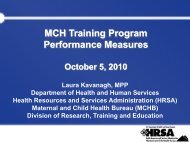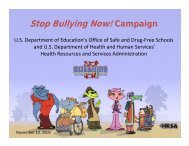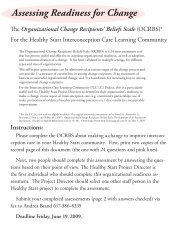2011 AMCHP and Family Voices National Conference ... - HRSA
2011 AMCHP and Family Voices National Conference ... - HRSA
2011 AMCHP and Family Voices National Conference ... - HRSA
Create successful ePaper yourself
Turn your PDF publications into a flip-book with our unique Google optimized e-Paper software.
<strong>2011</strong> <strong>AMCHP</strong> <strong>and</strong> <strong>Family</strong> <strong>Voices</strong> <strong>National</strong> <strong>Conference</strong>: Welcome Plenary <strong>and</strong><br />
MacQueen Memorial Lecture<br />
02/13/<strong>2011</strong> Omni Shoreham, Washington, D.C.<br />
this important? As researchers, such as Dr. David Barker, have shown,<br />
the fetal environment increases the risk for chronic disease in adulthood.<br />
This, coupled with social determinants, multiplies our risk for chronic<br />
disease, in reproductive age <strong>and</strong> throughout the life course. As an<br />
example here, the prevalence of obesity among women has been<br />
increasing over time, with increasing disparities for African-American <strong>and</strong><br />
Latino females. But it starts early in childhood, with the top slide<br />
showing age 0-5 <strong>and</strong> the split starting at age 6. But chronic disease also<br />
drives the tragic event of pregnancy related death as a leading cause of<br />
mortality during a time that should be among the healthiest periods of life.<br />
This requires an important call for action. Our center's action area is built<br />
upon the same foundation of MCH, to build public health infrastructure,<br />
healthy communities, <strong>and</strong> health care environments in collaboration with<br />
those communities <strong>and</strong> other partners. Specifically, several funding<br />
opportunities exist that allow reproductive health, MCH, <strong>and</strong> chronic<br />
disease prevention integration to now occur. For example community<br />
transformation grants will provide opportunities for local programs to<br />
think about life course perspective to improve health. We are also<br />
working together with other federal agencies on an important area of life<br />
course, addressing the winnable battle of teen pregnancy prevention. By<br />
working together, with other HHS federal partners <strong>and</strong> in communities,<br />
we're striving to improve health for our nation's youth. So, in the spirit of<br />
this year's conference, let us all continue to work together <strong>and</strong> to keep it in<br />
context in order to underst<strong>and</strong> the possible new ways that we can improve<br />
maternal <strong>and</strong> child health.<br />
PHYLLIS SLOYER: Thank you so much. It's refreshing to hear that presentation W<strong>and</strong>a. Our<br />
next presenter is Colleen Boyle, who I saw less than a month ago. She<br />
serves as acting director of the <strong>National</strong> Center on Birth Defects <strong>and</strong>




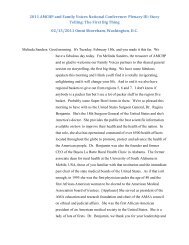



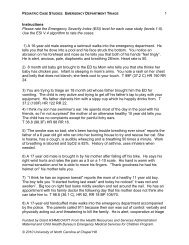
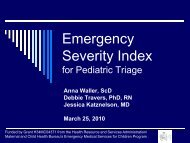
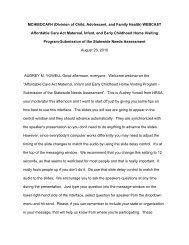
![Hormone Disruptors and Women's Health: Reasons for Concern [PDF]](https://img.yumpu.com/19410002/1/190x245/hormone-disruptors-and-womens-health-reasons-for-concern-pdf.jpg?quality=85)

